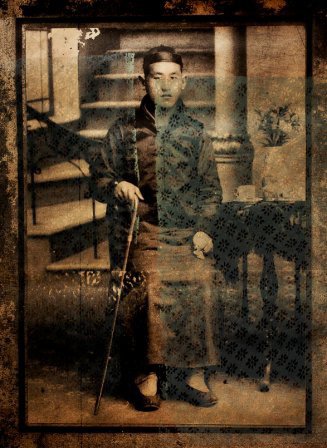Ekaterina Rozhkova
dal 27/10/2010 al 7/1/2011
Segnalato da
27/10/2010
Ekaterina Rozhkova
Sputnik Gallery, New York
Veil of Happiness. The artist's series of silkscreens contemplates the perpetual curiosity and relationship between the two great principal cultures of our globe, the East and the West. The project emerged as the result of the discovery of two separate photo albums from the turn of the twentieth century.

Ekaterina Rozhkova's Veil of Happiness series of silkscreens contemplates the perpetual
curiosity and relationship between the two great principal cultures of our globe, the East
and the West.
The project emerged as the result of the discovery of two separate photo albums from the
turn of the twentieth century. The first album, depicting the play by former French prime
minister Georges Clemenceau titled "Veil of Happiness," included 12 photographs of
European, perhaps amateur, actors performing scenes of everyday Chinese life in traditional
Chinese dress. The second album was comprised of staged photos on silk of Chinese models
dressed in traditional Chinese attire. Paradoxically, these scenes were created using the
canons of European photography of the time and were set against quintessentially
European backdrops.
In this project, Rozhkova reproduces the photographs found in those albums using a
combination of silkscreening and hand painting on paper or traditional Chinese patterned
silk. Underneath the imposed veil (of distance, both physical and cultural), the images
twinkle from beneath the translucent coating, and the material that the artist has chosen for
each image allows the images to retain all their own captivating aura for which they are
unique.
Rozhkova's Veil of Happiness represents a contemplation on how we accept, understand and
acclimate to an unknown and different culture. To the West, China has always been a
mysterious other culture, alien, yet inviting. The East is always present in our minds, in
some way present in our lives, yet so far away that our consciousness conceives it as
something completely different. In these works, we view Eastern culture through the
depiction of Frenchmen playing the role of Chinese men. Likewise, we view European
culture through the depiction of Chinese models playing the role of the Westerner.
Whether these images are presented through a theatrical podium or the artistic eye of an
unknown photographer, in both cases, the images are staged. We observe Easterners
undertaking an inept attempt to become acquainted with the West by recreating their
methods of portraiture, and similarly, Westerners attempting to understand Chinese life by
acting out the scenes of a play written by a Frenchman. The awkwardness of the actors and
subjects expose the naïveté of thinking it possible to understand a distant culture simply by
including it in one's own life.
To better understand the series, we must take into account the personal story of the artist
herself. Rozhkova is Russian by birth but spent several years living in China as a little girl.
This gives the project's East-West dichotomy a third dimension: Russia. To a Westerner,
Russia is associated with the East. To the Chinese, however, Russians are typical
Europeans. In these works, Russia, in the form of the artist herself, is presented as a
mediator between the two great principles. Thus, it could be said that Russia, as presented
in Rozhkova's works, forms that very tragic seam on the body of human culture that exists
between the two hemispheres. The veil imposed over the images is intended to create an
illusion of happiness and to cover and disguise the awkwardness of the human struggle
with another society's culture. - B. Mamonov
Ekaterina Rozhkova currently lives and works in Moscow, Russia. She has been widely
exhibited in Russia and throughout Europe in both solo and group shows. Veil of Happiness
is her first solo exhibition with Sputnik Gallery. Her work is part of many corporate and
private collections throughout the world.
Opening Reception: October 28 from 6 to 8 pm
Sputnik Gallery
547 W 27th Street, New York
Gallery Hours: Tuesday through Saturday 11 - 6 pm
Admissions free



